

Yosemite West Property & |
SRA is a State Responsibility Area where the State of California is financially responsible for the prevention and suppression of wildfires. An SRA does not include lands within incorporated city boundaries or federally owned lands. Yosemite West is in a SRA.
In 2011, California created the Fire Prevention Fee, which is administered by the Department of Forestry and Fire Protection (CAL FIRE) and collected annually by the State Board of Equalization. The fee is assessed on owners of habitable structures on property within a SRA. The purpose of the fee is to provide a stable source of funding for vital fire protection activities, defensible space inspections, fire prevention engineering, emergency evacuation planning, fire prevention education, fire hazard severity mapping, and other activities.
The bottom line is it's your money! You have paid into the fund as of the fiscal year starting 7/1/2012. The community basically wrote a grant to get access to money we have paid to the State.
In 2016, many property owners started addressing their tree mortality by hiring and paying for their own contractors rather than waiting for the grant to receive its authorization to start on-the-ground work. Unfortunately the grant cannot reimburse property owners for their out-of-pocket expenses.
In this area of and elevation in the Central Sierra current tree mortality is approaching 90% due to the drought and bark beetle infestation. The current forest surrounding Yosemite West has up to 1,000 tree stems per acre. In natural conditions, there would be only between 100 and 200 stems per acre, reducing to only 50 large trees per acre. Thinner forests improve overall forest health so trees can better withstand wildfire and resist pest attacks.
CAL FIRE's Bark Beetles & Dead Trees has FAQs, a Tree Mortality Map, and information on Dead Tree Removal, Tree Health, Seasonal Activities, and a Bark Beetle Campaign Toolkit.
The California Forest Stewardship Program publishes Tree Notes, numbered short papers on pests and threats to forests. Tree Notes 1 and 2 have information to consider when building. Tree Notes 8, 9, 10, 13, 19 and 28 describe the different beetles infesting and killing trees. Tree Notes 30 talks about dead and dying conifers.
Award-winning Canadian author Andrew Nikiforuk's book Empire of the Beetle: How Human Folly and a Tiny Bug Are Killing North America's Great Forests is a fascinating, informative read. You may even think differently about the bark beetle after reading it.
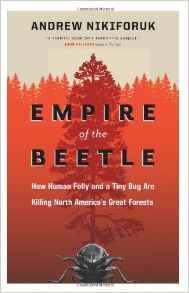
No, the trees will not come back to life and the weakened trees must be cut down to reduce the risk of wildfire and of their falling on structures and/or people.
See Henness Ridge Tree Mortality Aerial Images Taken 5/29/2017 that shows the ongoing threat.
No, just because a tree is still green, it doesn't mean it is not infected and won't die. You need to sign up because the die-off is continuing. Once bark beetles have successfully attacked a tree there is generally nothing you can do to save it. The project will consult with a RPF on issues of dying trees.
Bark beetles infect healthy green trees. Once a tree is dead and brown, the beetles are gone. Thinning live trees and reducing stem density is the best way to ensure healthy trees have enough water and nutrients to resist future beetle attacks.
A felled log flat on the ground is not a fire danger, but a standing dead tree is. The projects' scope does not include funding to remove logs. As a property owner, you own the timber, so it is up to you to decide what to do with it. If any individual property owner is interested in pursuing sale, barter or exchange of any timber from their property, they need to discuss it with a Licensed Timber Operator (LTO). A LTO can remove the logs for you, possibly at little or no cost if they have a market for the timber, by filing a Drought Mortality Exemption CCR 14§ 1038(k) with CAL FIRE. If you are interested, you should discuss this with a LTO. Download a list of California Timber Operators.
Keep in mind that logs need to be almost 40 feet long to be transported by a logging truck. Not all logs will meet this minimum criteria. Dead trees may shatter when felled. In many cases, dead trees in close proximity to structures will not be felled with a single cut because there will not be enough room to do safely; the sawyer may have to climb the tree, and drop it in short sections. This determination can only be made by the sawyer once on site.
Any property owner who wants to sell, trade or barter any wood from conifers from their property must comply with the Z'berg - Nejedly Forest Practice Act of 1973 (FPA) and Forest Practice Rules (FPR). The FPA is contained in Public Resources Code §4511 where forestry boards in California developed specific FPRs to protect public resources on non-federal lands. These laws apply to forests containing species with commercial value, generally defined as all conifers. Current information is found in the 2015 CalFire Forest Practice Rulebook; Section 4527 states in part, "...the cutting or removal of trees that are processed into logs, lumber, or other wood products and offered for sale, barter, exchange, or trade is defined as a ‘Commercial purpose,' and can be done only by a Licensed Timber Operator."
PurFIRE, a Groveland-based company, specializes in the use of a portable air curtain burner to efficiently process slash and debris into ash without chipping, hauling, or use of accelerants. Property owners whose parcels are relatively flat with sufficient clearance for safe operation of their air curtain burner, may find this to be an affordable and desirable method.
Adult bark beetles lay eggs under the bark of stressed-out trees. Their larvae then feed on the tree's living tissue. Normally, a healthy tree can successfully defend an attack by "pitching" the beetles out with sap. But, a large unrelenting infestation can kill any tree.
| Bark Beetle Larvae & Galleries Under Bark | ||
|---|---|---|
| This sugar pine tree was a recent fade that was felled in August 2016 shortly after it died. Hundreds of inch-long, white, worm-like larvae were alive under the bark having created channels called "galleries" under the bark. After debarking, the larvae were dead or gone within a day by a combination of heat exposure and being preyed upon by ravens, skinks and even a wild turkey. | ||
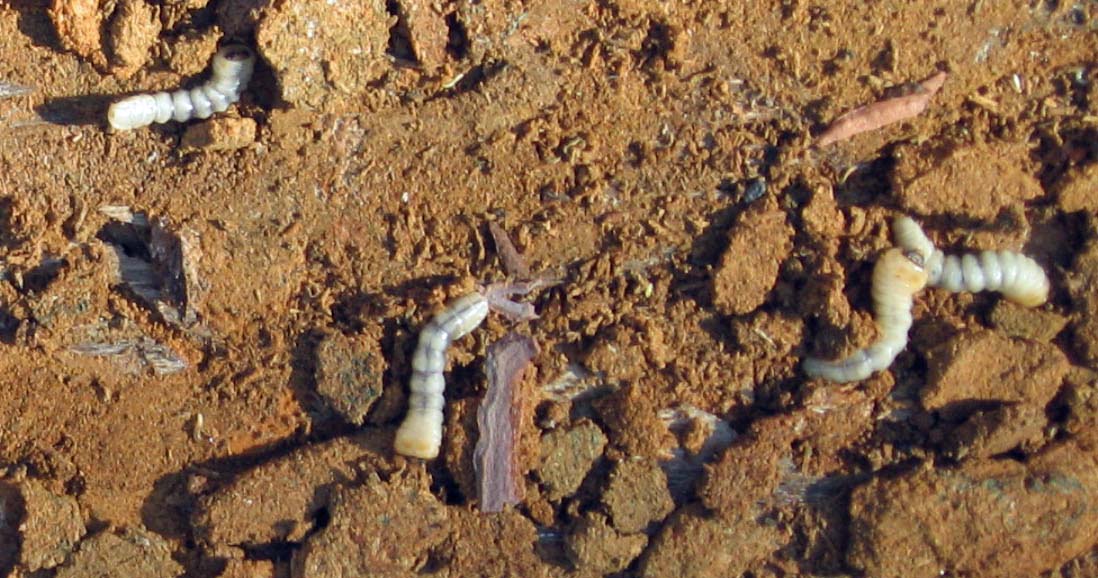
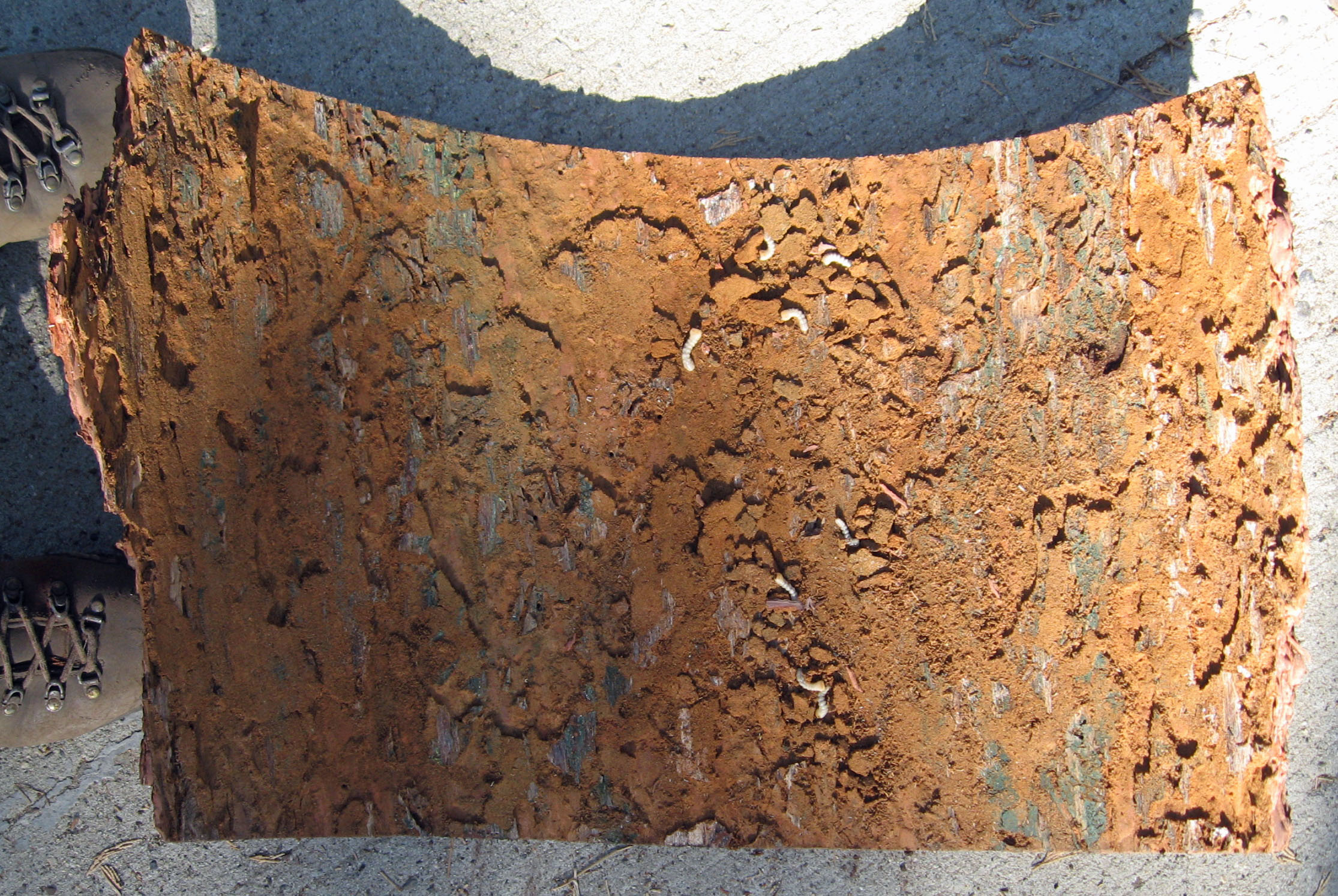
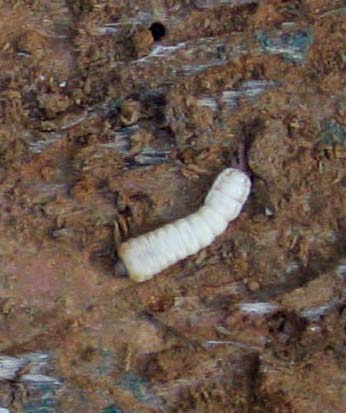
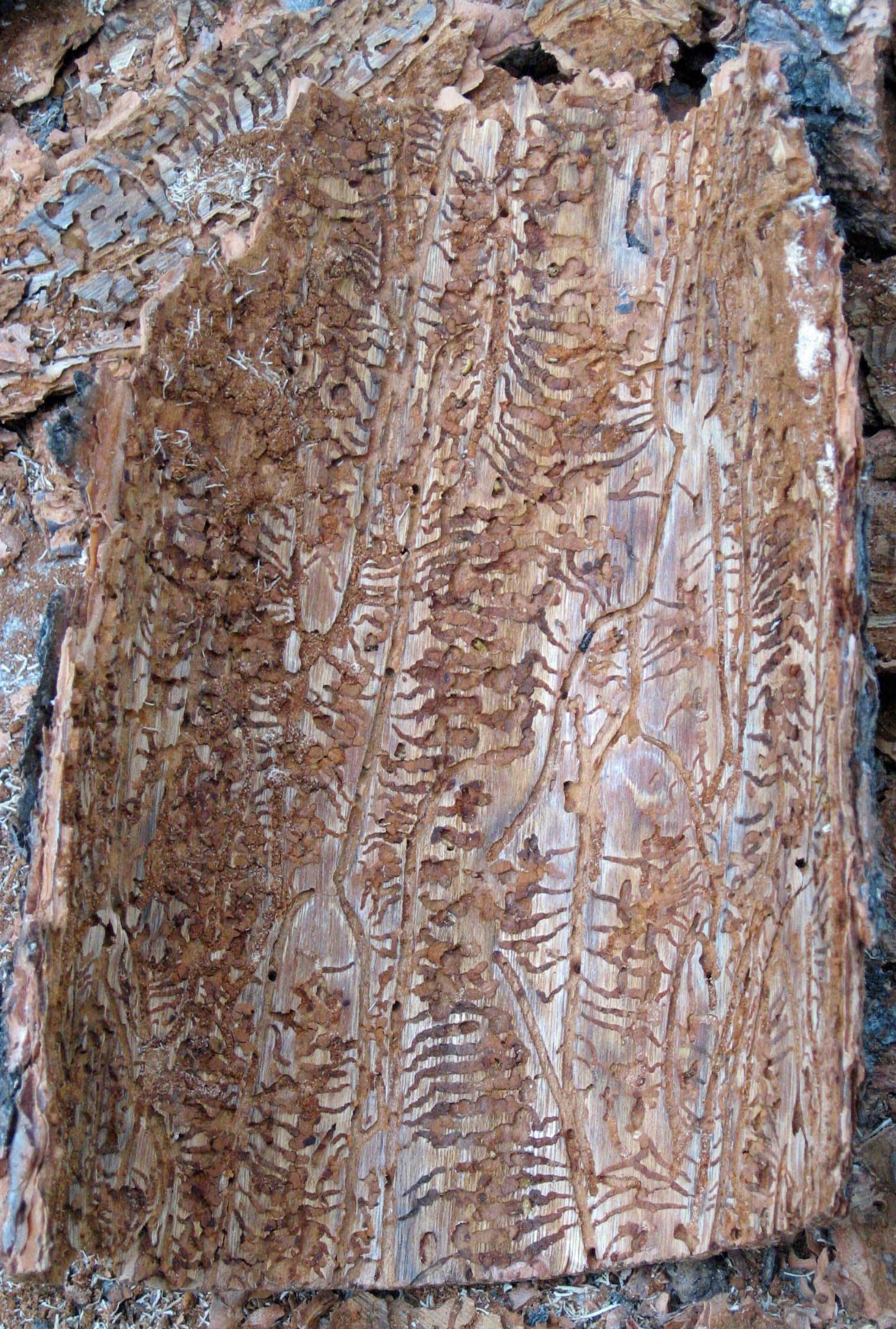
|
To help stop the spread of bark beetles and if you intend to use felled beetle-infested logs for firewood, it is necessary to debark felled logs. Debarking (or removing the bark) destroys the habitat where beetles breed and their larvae feed. Beetles cannot survive in bark alone or inside debarked logs. Debark within five weeks of felling an infested tree because it is easier to debark freshly felled trees and it kills beetle larvae and pupa before they matures into adult beetles that can fly and infest other trees.
Once you have debarked your logs, tarp and seal wood piles with clear plastic to "bake" any remaining beetles from the wood. This technique can also prevent beetles from colonizing freshly cut uninfested wood piles. Read Controlling Bark Beetles in Wood Residue and Firewood.
Chip the slash from felled trees because beetle broods cannot survive in chips. October to January is an ideal time to remove dying or dead trees that show evidence of being infested. Clean up all debris and chip or burn it before spring when adult beetles emerge. If you don't debark and address the debris, beetles within these trees will continue to grow and attack nearby pines. Even after the wet and cold winter of 2016-2017, beetle larvae have been found alive in April 2017 underneath bark of trees felled in September 2016. The larvae have not yet matured, so there is still time to debark now.
By now, we all understand how beetles are killing trees, but many of us have ever heard of another serious problem affecting our forest; conks.
Conks are fungal pathogens or fruiting bodies of fungi that attach to tree trunks, typically by entering through bark wounds. These hard solid growths may have a shelf-like appearance (shelf or bracket fungi), appear singly, or resemble mushrooms.
Some varieties of conks decay the wood of healthy trees, but normally conks appear on dead or decaying wood. From the conk's attachment point on the trunk, decay may extend as far away as 15 feet. Disease may exist for several years before conks appear. By the time you see a conk, it is a strong indication that the tree suffers from dead wood due to extensive damage to the tree's heartwood or sapwood (or both) inside the tree. This internal damage is irreparable.
Since conks weaken the tree structure, they can endanger people and/or structures. Conks can also cause root rot, so an entire tree may be susceptible to toppling in high winds or under heavy snow.
If you see trees with conks close to your house (or on your property and close to a neighbors' house), the safest method for removal may be using a crane since these trees may be too dangerous for a sawyer to climb and "piece" or section to remove. Because of the physical danger to sawyers and the expense of crane work, if the project identifies any such trees on your property, the project will notify you and exclude these trees from the project. If the project identifies trees with conks that can be safely felled as determined by the sole discretion of the sawyer, it will fell these trees. Addressing trees with conks at the onset of the project may take priority over other standing dead trees.
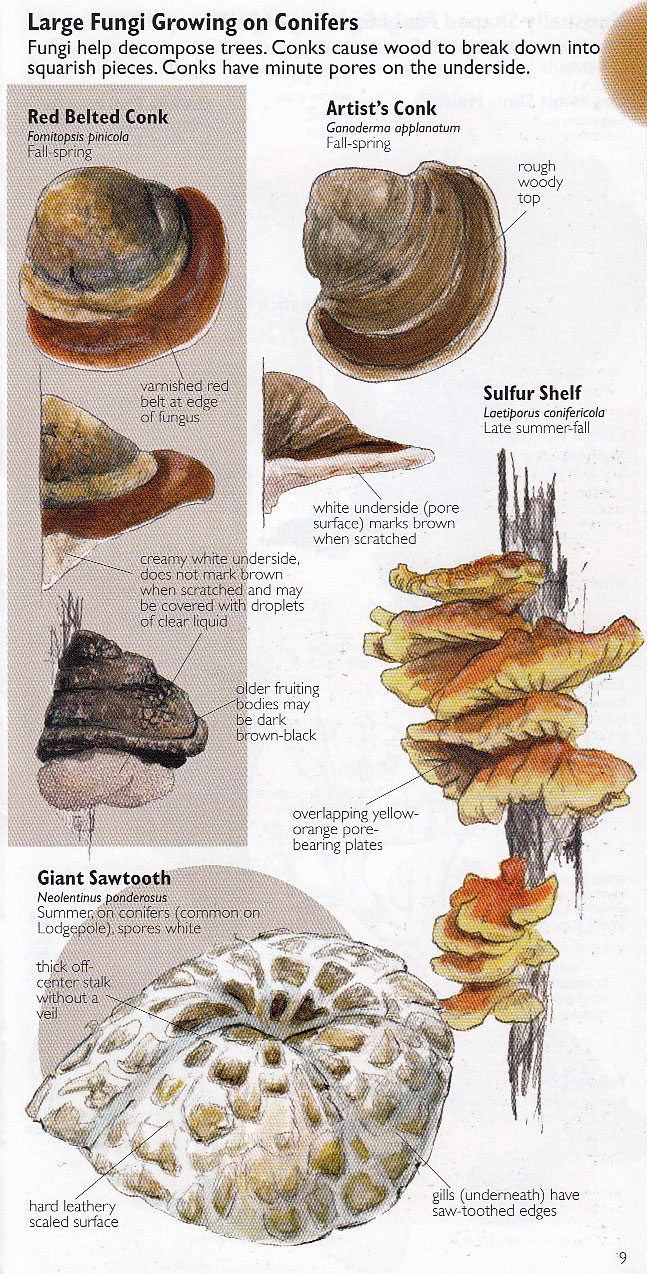
"Large Fungi Growing on Conifers" (p.9) from The Laws Field Guide to the Sierra Nevada by John Muir Laws
We will post images of conks found in Yosemite West as we document them.
Mariposa County contracted with Blue Ridge Services, Inc. to address tree mortality in the County. Their project has nothing to do with the two CAL FIRE SRAFPF grants implemented in Yosemite West. Please direct any questions to Blue Ridge Services, Inc. and not to YWPHI or its grant liaisons. If you know that you no longer have any dead trees, you do not need to do anything.
Contact Blue Ridge Services, Inc. who has been contracted by Mariposa County to address tree mortality in the County. Do not contact the YWPHI or the YWPHI Grant Liaisons.
Please email grants@yosemitewest.org with any questions you may have.
Back to << 2015-2016 CAL FIRE's State Responsibility Area Fire Prevention Fund (SRAFPF) Grant
 Copyright text © Yosemite West Property & Homeowners, Inc. 2003-2017. Copyright photographs © John Mock 2004-2017. All rights reserved. Unauthorized redistribution of this document is prohibited. Updated June 4, 2018. |